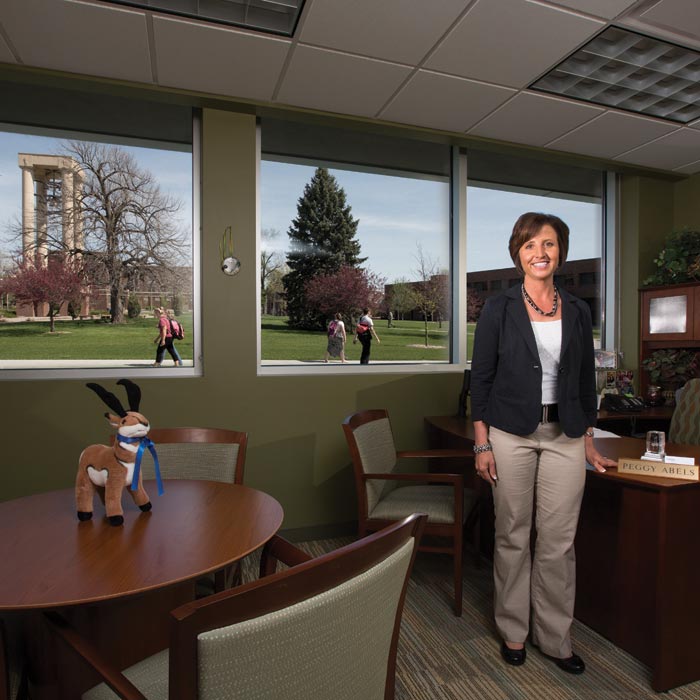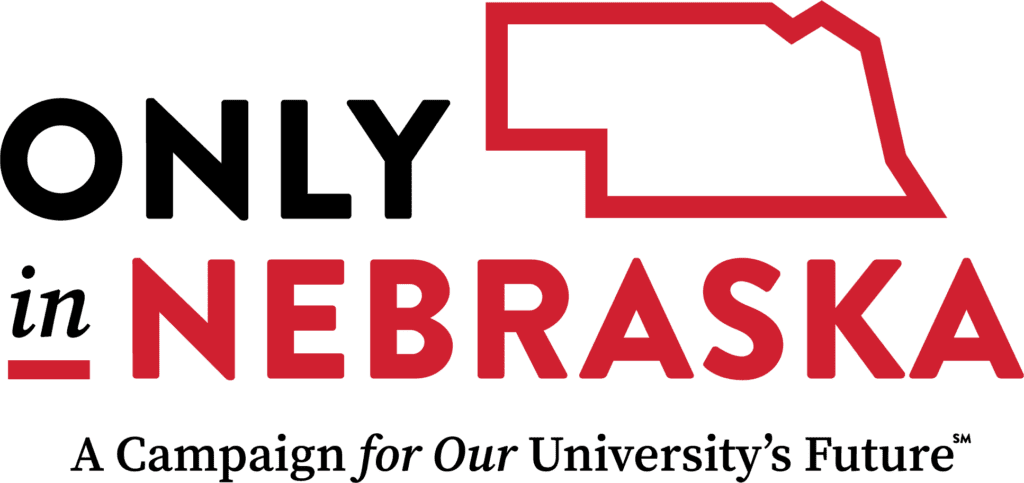Health Science now a big fish on campus


Because of the department’s rising reputation, Health Sciences is gaining popularity.
The home of Health Sciences at UNK used to be a single small room in Bruner Hall, maybe 12 feet by 12 feet.
One of its walls was solid glass, so people walking by would stare at the department’s three workers crammed inside like sardines – the intern, the secretary and Peggy Abels, the young director.
“We called it the ‘fish bowl,'” Abels says, smiling as she recalled those days in the late ’90s. “It was kind of embarrassing. Students would sometimes laugh about it. Other faculty members would comment on it.”
The department’s home now takes up prime real estate on the first floor of the renovated Bruner Hall. Abels has her own office. It’s beige and sage and spacious, with plenty of room for her to visit with students at the table and talk about their futures in health care, something she loves to do.
Most of one long wall is a window that looks to the center of campus, the bell tower and the flow of students walking by.
They wave from the other side of the glass.
She waves back.
Many of those students are hers – students lured to UNK by her department’s quality and rising reputation.
Health Sciences is now a big fish on campus.
Maybe the big fish.
Health Sciences is the biggest area of study at UNK. It has more than 700 students, up from 320 students in 2000 and 250 when Abels started as director in 1996. And as the number of students has risen, so has the quality of those students.
People credit Abels for much of the growth.
“She’s been a huge asset,” says UNK grad Terry Becker, M.D., who has a family practice in Kearney. “Just the whole vibe, the whole experience is so much different and so much better than when I went through 20 years ago. And Peggy’s really headed a lot of those things.”
Jeff Hill, M.D., is associate dean of admissions for UNMC’s medical school. He says he’s seen the quality of med school applicants from UNK rise.
“Not to say they weren’t good before,” Hill says. “But now these Kearney kids are very well prepared. With Peggy as a resource, these kids come with a complete package.”
Health Sciences consists of 15 pre-professional programs such as pre-medicine, pre-dentistry, pre-pharmacy, prephysical therapy. It has four degree programs: radiography, respiratory therapy, medical technology and – through UNMC – nursing.
One-tenth of all the students on campus now want careers in health care. But these aren’t just any students. These are among the best and brightest who previously might have gone elsewhere for their undergraduate degree.
Many of those students grew up in small towns in central and western Nebraska. Many would rather do their undergraduate work closer to home. Many of those students want to live and work in rural Nebraska – young people like Andy Craig, a recent UNK graduate who’s completing his residency at UNMC.
“I think what she’s doing is benefiting the whole state, not just Kearney itself,” Craig says. “A lot of students going to UNK who want to go to medical school end up coming back to rural Nebraska towns following residency.”
Craig grew up in Minden, a small town southeast of Kearney. He graduated from UNK in 2007 with a degree in exercise science and worked as a phlebotomist in Omaha before returning to Kearney for a year of post-baccalaureate studies. He worked for Abels as a graduate assistant.
He saw her in action.
“She’s not afraid to tackle any task,” Craig says. “And there’s no student who thinks twice about coming in to talk to her. When I was an undergraduate, I loved going in for my advising appointments. She took an effort to not only know what classes I was taking, but to get to know me as a human being.
“She meets with hundreds of students each year for advising, and she could tell you a little bit about each one – that’s the kind of person she is.”
2010 was a great year for her department. Besides moving into its larger home in Bruner Hall, it also saw the start of the Kearney Health Opportunities Program (KHOP), a cooperative program between UNK and UNMC that recruits and educates students from rural Nebraska – like Andy Craig –who are committed to returning to rural Nebraska to work.
Abels says the success of that joint program with UNMC, as well as other collaborations in recent years between the two schools, set the stage for the Building a Healthier Nebraska Initiative. The initiative, funded by the state and private donations, seeks to address the critical shortage of health care providers in the state. It includes a new $19 million, 40,000-square-foot Health Science Education Complex to be built on the UNK campus.
The new facility would allow UNK and UNMC to enroll almost 30 percent more nursing students and would add training in allied health professional programs in Kearney such as physical therapy, physician assistant, clinical lab science and radiography.
Health Sciences also is the fastest-growing area at UNK. The department is expected to grow 20 percent through 2015. The Building a Healthier Nebraska Initiative will likely increase enrollment in Health Sciences at UNK about 10 percent beyond that.
“It’s really the perfect kind of program because everybody wins,” Abels says. “I can’t tell you the number of times students have said to me, ‘I really want to go into health care, but I don’t want to move to Omaha.’ The students win because they can come here for their college experience and stay here at UNK for their professional school training in the health sciences.
“UNK will win in terms of recruitment and recognition. Our faculty and students will benefit from collaboration with UNMC faculty and students. And, of course, UNMC will benefit because it will be able to reach out into the state and make a bigger impact in rural Nebraska.
“But probably the big winner will be the people of the state of Nebraska, especially people in central and western Nebraska. The goal of the Building a Healthier Nebraska Initiative at UNK is to provide health care practitioners for rural Nebraska into the future. The data shows that students that are from rural areas are much more likely to return to rural areas to practice. Bringing health science education to central Nebraska further increases that likelihood.”
Abels grew up in rural Nebraska herself, on a farm 15 miles south of Ewing. Her parents and many relatives still live there. When they need to see a doctor or health care provider, they often drive up to an hour to places like O’Neill and Norfolk. So she’s seen firsthand the need for rural health care providers.
She also understands what it’s like to be a Loper.
“Having been an undergrad and grad student here, I think that’s been extremely beneficial in my position, especially in recruiting,” she says. “I can talk to students and parents about the strengths of UNK and what makes this place great from a student perspective.”
Andy Craig, the former Loper who’s now studying to be a rural doctor, isn’t surprised Health Sciences has grown so much.
“I just think that a lot of my positive experience at UNK was due to Peggy Abels, and due to the Health Science Programs Office,” he says. “I’ve got two sons, and I will encourage them to go to UNK someday, especially if they want to pursue a degree in the health sciences.
“I don’t think you can get better undergraduate training anywhere in the state.”
Support for amazing faculty members like Peggy Abels is a top priority of the Campaign for Nebraska. If you’d like to help her health sciences program at UNK – and its students who one day will help people across the state with their health care needs – please consider giving online to the Building a Healthier Nebraska UNK Health Sciences Education Complex Fund. Or you can contact the foundation at 800-432-3216.





